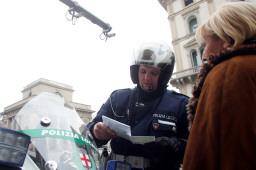A key environmental report gave Italy a mixed bill of health on Tuesday, warning of critical air quality and rising car numbers but praising a spread in greenery and a drop in smog. Commenting on the results of the study, Environment Minister Alfonso Pecoraro Scanio said there was still work to be done but expressed cautious optimism. ''The situation has improved given the grim conditions to start with but drastic measures are still needed,'' he said. ''The challenge now is to make urban areas more liveable''. The annual study by Italy's Environmental Protection Agency (APAT) compares living standards in Italy's 24 cities with over 150,000 inhabitants. Looking at changes between 2000 and 2006, the agency said important developments had been made in certain areas, such as waste management and greenery, but stressed there was still much room for improvement.
Italians continue to rely on their cars too much, APAT noted, with cities such as Rome, Modena and Catania counting nearly 700 vehicles for every 1000 inhabitants. But while car ownership is on the rise in Italy, some cities are bucking the trend. The percentage of residents in Milan with cars dropped 9% between 2000 and 2006, while in Naples, vehicle numbers fell 6%.
Another positive development in recent years is the rising percentage of low-emission vehicles. Over 10% of cars on the road now meet the European Union's Euro 4 standards on low emissions, said APAT, rising to nearly a quarter of all vehicles in Rome. The agency noted that cars were the chief culprits for poor air quality in 19 of the 24 Italian cities it looked at. In 11 cities, cars were to blame for over 50% for emissions dangerous to human health, rising to over 60% in Rome, Turin and Messina.
The report said levels of nitrogen oxides, carbon dioxide, carbon monoxide, benzene and sulphur dioxide were all on the rise. APAT also sounded the alarm over concentrations of PM10, dust particles smaller than 10 micrometers in diameter, able to enter human lungs through the nose and mouth.
Levels of PM10, which is thought to cause over 8,000 deaths in Italy each year, have fallen in recent years nationwide but are still dangerously high, said the report. APAT's findings on waste were mixed.
Although refuse levels rose 5.1% in Italian cities between 2002 and 2006, the report was upbeat about recycling and differentiated waste collections. In cities such as Padua, Turin, Brescia and Prato, well over a third of all waste is now separated for collection.
The report was also upbeat about the spread of parks and green areas in Italy's cities. Naples took first place, with a 19.5% increase in public green spaces between 2000 and 2006, followed by Cagliari, up 8%, and Turin with a 5.6% rise. Overall, Cagliari was Italy's greenest city, with 56% of public land given over to park space. Verona followed with 45.6% and Palermo with 33.6%. photo: motorist gets info on Milan's new vehicle pollution charge













